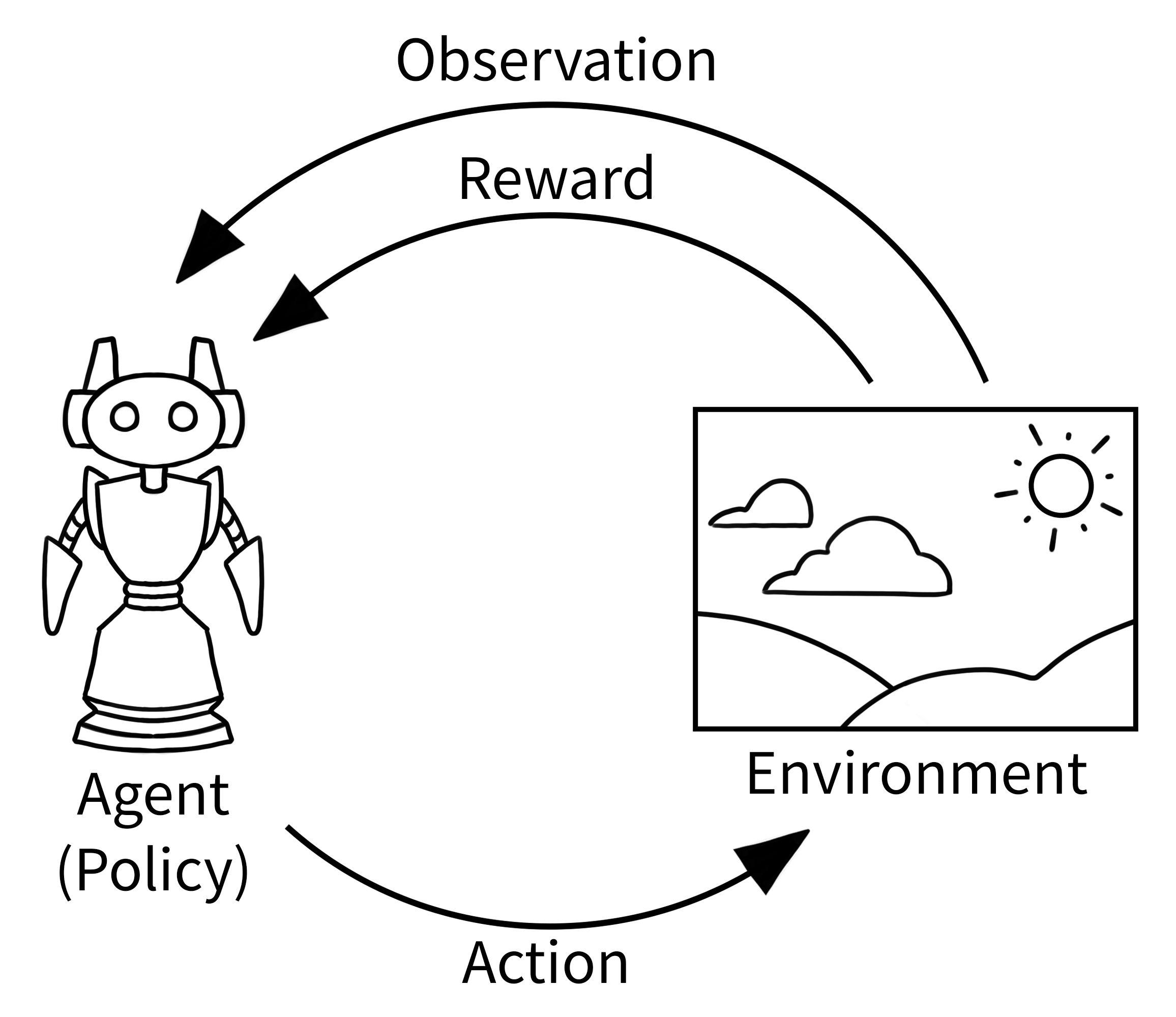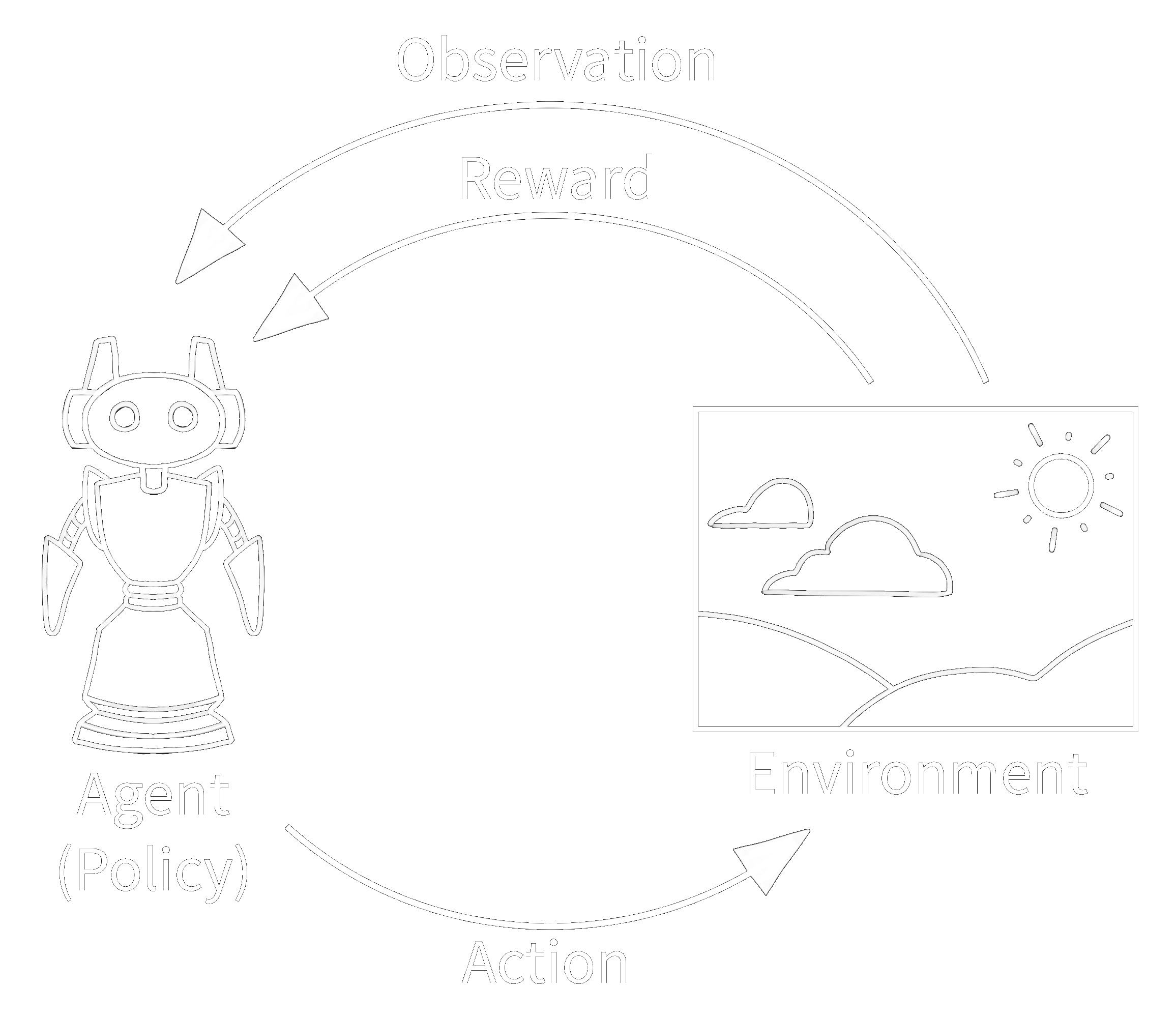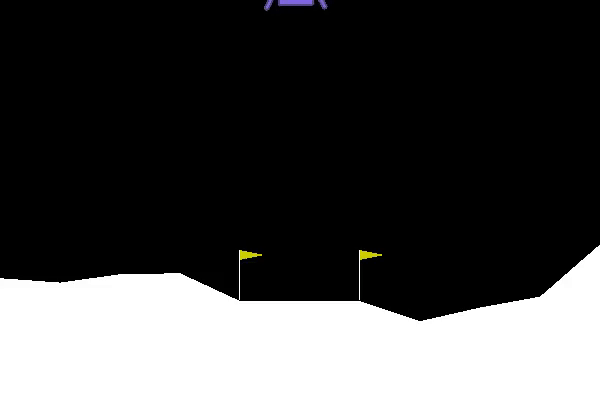Basic Usage¶
Initializing Environments¶
Initializing environments is very easy in Gym and can be done via:
import gym
env = gym.make('CartPole-v0')
Interacting with the Environment¶
Gym implements the classic “agent-environment loop”:


The agent performs some actions in the environment (usually by passing some control inputs to the environment, e.g. torque inputs of motors) and observes how the environment’s state changes. One such action-observation exchange is referred to as a timestep.
The goal in RL is to manipulate the environment in some specific way. For instance, we want the agent to navigate a robot to a specific point in space. If it succeeds in doing this (or makes some progress towards that goal), it will receive a positive reward alongside the observation for this timestep. The reward may also be negative or 0, if the agent did not yet succeed (or did not make any progress). The agent will then be trained to maximize the reward it accumulates over many timesteps.
After some timesteps, the environment may enter a terminal state. For instance, the robot may have crashed! In that case, we want to reset the environment to a new initial state. The environment issues a done signal to the agent if it enters such a terminal state. Not all done signals must be triggered by a “catastrophic failure”: Sometimes we also want to issue a done signal after a fixed number of timesteps, or if the agent has succeeded in completing some task in the environment.
Let’s see what the agent-environment loop looks like in Gym.
This example will run an instance of LunarLander-v2 environment for 1000 timesteps. Since we pass render_mode="human", you should see a window pop up rendering the environment.
import gym
env = gym.make("LunarLander-v2", render_mode="human")
env.action_space.seed(42)
observation, info = env.reset(seed=42)
for _ in range(1000):
observation, reward, terminated, truncated, info = env.step(env.action_space.sample())
if terminated or truncated:
observation, info = env.reset()
env.close()
The output should look something like this

Every environment specifies the format of valid actions by providing an env.action_space attribute. Similarly,
the format of valid observations is specified by env.observation_space.
In the example above we sampled random actions via env.action_space.sample(). Note that we need to seed the action space separately from the
environment to ensure reproducible samples.
Checking API-Conformity¶
If you have implemented a custom environment and would like to perform a sanity check to make sure that it conforms to the API, you can run:
>>> from gym.utils.env_checker import check_env
>>> check_env(env)
This function will throw an exception if it seems like your environment does not follow the Gym API. It will also produce
warnings if it looks like you made a mistake or do not follow a best practice (e.g. if observation_space looks like
an image but does not have the right dtype). Warnings can be turned off by passing warn=False. By default, check_env will
not check the render method. To change this behavior, you can pass skip_render_check=False.
After running
check_envon an environment, you should not reuse the instance that was checked, as it may have already been closed!
Spaces¶
Spaces are usually used to specify the format of valid actions and observations.
Every environment should have the attributes action_space and observation_space, both of which should be instances
of classes that inherit from Space.
There are multiple Space types available in Gym:
Box: describes an n-dimensional continuous space. It’s a bounded space where we can define the upper and lower limits which describe the valid values our observations can take.Discrete: describes a discrete space where {0, 1, …, n-1} are the possible values our observation or action can take. Values can be shifted to {a, a+1, …, a+n-1} using an optional argument.Dict: represents a dictionary of simple spaces.Tuple: represents a tuple of simple spaces.MultiBinary: creates a n-shape binary space. Argument n can be a number or alistof numbers.MultiDiscrete: consists of a series ofDiscreteaction spaces with a different number of actions in each element.
>>> from gym.spaces import Box, Discrete, Dict, Tuple, MultiBinary, MultiDiscrete
>>>
>>> observation_space = Box(low=-1.0, high=2.0, shape=(3,), dtype=np.float32)
>>> observation_space.sample()
[ 1.6952509 -0.4399011 -0.7981693]
>>>
>>> observation_space = Discrete(4)
>>> observation_space.sample()
1
>>>
>>> observation_space = Discrete(5, start=-2)
>>> observation_space.sample()
-2
>>>
>>> observation_space = Dict({"position": Discrete(2), "velocity": Discrete(3)})
>>> observation_space.sample()
OrderedDict([('position', 0), ('velocity', 1)])
>>>
>>> observation_space = Tuple((Discrete(2), Discrete(3)))
>>> observation_space.sample()
(1, 2)
>>>
>>> observation_space = MultiBinary(5)
>>> observation_space.sample()
[1 1 1 0 1]
>>>
>>> observation_space = MultiDiscrete([ 5, 2, 2 ])
>>> observation_space.sample()
[3 0 0]
Wrappers¶
Wrappers are a convenient way to modify an existing environment without having to alter the underlying code directly.
Using wrappers will allow you to avoid a lot of boilerplate code and make your environment more modular. Wrappers can
also be chained to combine their effects. Most environments that are generated via gym.make will already be wrapped by default.
In order to wrap an environment, you must first initialize a base environment. Then you can pass this environment along with (possibly optional) parameters to the wrapper’s constructor:
>>> import gym
>>> from gym.wrappers import RescaleAction
>>> base_env = gym.make("BipedalWalker-v3")
>>> base_env.action_space
Box([-1. -1. -1. -1.], [1. 1. 1. 1.], (4,), float32)
>>> wrapped_env = RescaleAction(base_env, min_action=0, max_action=1)
>>> wrapped_env.action_space
Box([0. 0. 0. 0.], [1. 1. 1. 1.], (4,), float32)
There are three very common things you might want a wrapper to do:
Transform actions before applying them to the base environment
Transform observations that are returned by the base environment
Transform rewards that are returned by the base environment
Such wrappers can be easily implemented by inheriting from ActionWrapper, ObservationWrapper, or RewardWrapper and implementing the
respective transformation.
However, sometimes you might need to implement a wrapper that does some more complicated modifications (e.g. modify the
reward based on data in info). Such wrappers
can be implemented by inheriting from Wrapper.
Gym already provides many commonly used wrappers for you. Some examples:
TimeLimit: Issue a done signal if a maximum number of timesteps has been exceeded (or the base environment has issued a done signal).ClipAction: Clip the action such that it lies in the action space (of typeBox).RescaleAction: Rescale actions to lie in a specified intervalTimeAwareObservation: Add information about the index of timestep to observation. In some cases helpful to ensure that transitions are Markov.
If you have a wrapped environment, and you want to get the unwrapped environment underneath all of the layers of wrappers (so that you can manually call a function or change some underlying aspect of the environment), you can use the .unwrapped attribute. If the environment is already a base environment, the .unwrapped attribute will just return itself.
>>> wrapped_env
<RescaleAction<TimeLimit<BipedalWalker<BipedalWalker-v3>>>>
>>> wrapped_env.unwrapped
<gym.envs.box2d.bipedal_walker.BipedalWalker object at 0x7f87d70712d0>
Playing within an environment¶
You can also play the environment using your keyboard using the play function in gym.utils.play.
from gym.utils.play import play
play(gym.make('Pong-v0'))
This opens a window of the environment and allows you to control the agent using your keyboard.
Playing using the keyboard requires a key-action map. This map should have type dict[tuple[int], int | None], which maps the keys pressed to action performed.
For example, if pressing the keys w and space at the same time is supposed to perform action 2, then the key_to_action dict should look like:
{
# ...
(ord('w'), ord(' ')): 2,
# ...
}
As a more complete example, let’s say we wish to play with CartPole-v0 using our left and right arrow keys. The code would be as follows:
import gym
import pygame
from gym.utils.play import play
mapping = {(pygame.K_LEFT,): 0, (pygame.K_RIGHT,): 1}
play(gym.make("CartPole-v0"), keys_to_action=mapping)
where we obtain the corresponding key ID constants from pygame. If the key_to_action argument is not specified, then the default key_to_action mapping for that env is used, if provided.
Furthermore, if you wish to plot real time statistics as you play, you can use gym.utils.play.PlayPlot. Here’s some sample code for plotting the reward for last 5 second of gameplay:
def callback(obs_t, obs_tp1, action, rew, done, info):
return [rew,]
plotter = PlayPlot(callback, 30 * 5, ["reward"])
env = gym.make("Pong-v0")
play(env, callback=plotter.callback)

